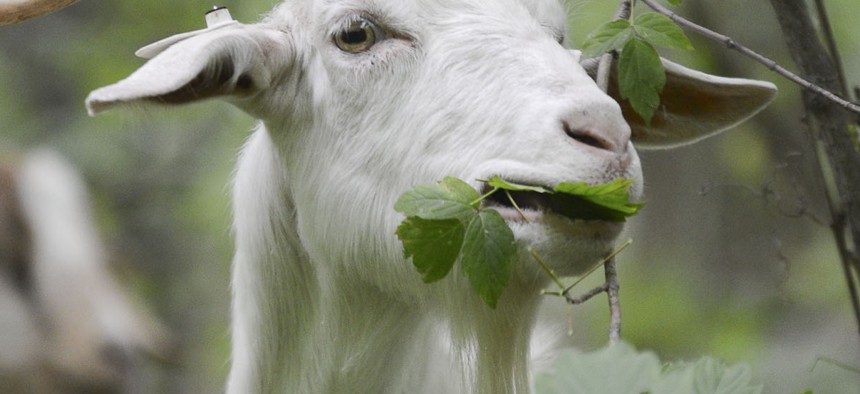This City Park Is Using Goats to Remove Invasive Plant Species

The goats, mostly females and their kids, eat buckthorn and other unwanted vegetation. Minneapolis Park and Recreation Board
It's the goats' second season at Theodore Wirth Regional Park, a project spearheaded by the Minneapolis Park and Recreation Board.
In a city park in Minneapolis, an unusual group of contract workers spreads out for days a time, battling invasive plants, acre by acre.
They travel on foot from place to place, munching on unwanted vegetation at their own pace. As a precaution, the group—a herd of about 45 goats, on loan from a local company—are kept in place by fencing and are supervised at all times, 24 hours a day, by a contractor, mostly for their own safety.
This month marks the goats’ second season at Theodore Wirth Regional Park, in an invasive-species control project spearheaded by the Minneapolis Park and Recreation Board. Commissioners had been debating the measure for a while and finally went live with it last year at two different parks, said Robin Smothers, a spokeswoman for the board.
“They eat primarily buckthorn, an invasive species, and other unwanted vegetation,” Smothers told Route Fifty. “We also use other methods to control invasive species, such as hand removal, mowing and herbicides if necessary. The goats complement that work and are used in areas that are harder to reach.”

It’s not an entirely uncommon practice. Parks and nature conservancies in Wisconsin and Michigan have launched similar programs in recent years, and studies have found that deploying herbivores to destroy invasive species can be more effective than pesticides and don't come with the environmental drawbacks.
In Minneapolis, the goats—mainly females and their kids—are provided by Diversity Landworks, which contracts with the city for the service. The company has worked with other municipalities and government entities to help with land management, ranging from the U.S. Forest Service and U.S. Fish and Wildlife to Minneapolis and the city of Redwing, Minnesota. Allowing goats to graze the land is a return to traditional land management that benefits both the plants and the animals, said Kyle Johnson, owner of Diversity Landworks.
"We got to the point where we realized the problem with all land management now is that we've essentially removed animals from the land and put them in confinement," Johnson told Route Fifty. "Plant species evolved to be grazed, and that whole dynamic has changed."
The goats prefer leafy shrubs (including buckthorn and honeysuckle, two of the main invasive species in the area), and like to eat greenery that grows above the ground, meaning there's little risk that they'll accidentally munch on native species during their work, Johnson said.
Unleashing the goats in urban areas is more expensive than in rural paddocks, due mostly to insurance and permitting costs as well as fencing requirements. Last year, Minneapolis paid about $34,000 to hire the goats to graze three sites at two parks. This year, for two sites at one park, the cost is $21,000. Each site and season takes a different amount of time, and the goats remain in the park until their task is finished. Last year, that took between six and 10 days, Smothers said.
At the end of the season, the park board will assess the efficiency and economic viability of the program, including how well native plants bounce back as compared to the invasive species, the Southwest Journal reported.
Park visitors are discouraged from interacting with the goats—they’re working, after all—but are free to observe the herd from afar.
“A temporary double fence will allow the public to view these hard-working animals from a safe distance,” Smothers said.
Kate Elizabeth Queram is a Staff Correspondent for Government Executive’s Route Fifty and is based in Washington, D.C.
NEXT STORY: All 50 States Now Protect Public Breastfeeding





